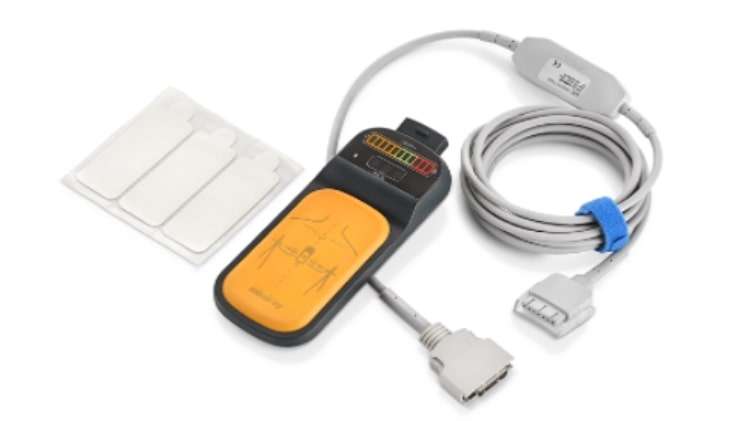What Does a Chest Compressions Feedback Device Monitor in AED Equipment?

Sudden cardiac arrest (SCA) causes a high death rate worldwide[1] because the heart of an SCA patient fails to pump blood and oxygen to the brain and other parts of the body due to a malfunction in the normal electrical pathway of the heart. Once the brain and body are deprived of blood supply, death can occur within minutes. In this situation, cardiopulmonary resuscitation (CPR), which uses chest compressions to get the blood flowing throughout the body, is considered an effective way to save a patient with SCA.
The Significance of CPR in SCA Rescue
CPR refers to the traditional cardiopulmonary resuscitation technique in which a responder performs chest compressions at a rate of 100 to 120 beats per minute and a depth of at least 2 inches (5 cm) on an SCA patient to maintain blood flow and mouth-to-mouth breathing to deliver oxygen to the lungs. During CPR, the ratio of compressions to breaths is 30:2, i.e., 30 chest compressions require two mouth-to-mouth breaths for the patient. CPR is a critical step in the SCA survival chain as it is reported that immediate CPR doubles or triples the chance of survival for cardiac arrest.
The Requirement for Chest Compression Feedback Devices
Nevertheless, SCA is always unpredictable, and there is no guarantee that the patient will have a professional at his or her side immediately when SCA occurs. In fact, most SCAs occur in public places outside the hospital. In offices, schools, gymnasiums, or other public places, bystander proficiency in resuscitation may vary widely, and there is a lack of standardized criteria for them to judge CPR quality, making the quality of CPR received by SCA patients uneven. In addition, chest compressions in adults are typically 5 inches deep, equivalent to 5 cm – 6 cm, with a compression frequency of 100-120 compressions per minute. Even for experienced professionals, performing chest compressions at an effective and correct depth and rate can be challenging.
Inexperienced and unprofessional rescuers need more detailed CPR feedback instructions, and other more experienced rescuers need simple cues to help them perform high-quality chest compressions quickly and effectively. Therefore, CPR feedback devices become necessary during SCA rescues in these situations. Moreover, the 2015 AHA CPR and ECC guidelines call for the inclusion of CPR feedback devices in adult CPR courses to help double the survival rate of cardiac arrests through high-quality CPR.[2]
What Does Chest Compression Feedback Device Monitor?
A chest compression feedback device is, as the name implies, a small device used to assess the quality of cardiopulmonary resuscitation. The chest compression feedback device monitors the speed, depth, hand position, and chest recoil of chest compressions based on a three-dimensional induction magnetic field primarily to see if they meet the standards required for CPR, and provides timely feedback so that the rescuer can adjust the speed and depth promptly. According to a study conducted by Brown LL, the use of CPR feedback devices can effectively improve the quality and performance of CPR[3].

Chest Compressions Feedback Device in AED Equipment
AED defibrillation and CPR on a patient in cardiac arrest are the most effective way to save an SCA patient. CPR is often performed before and after defibrillation to increase the likelihood of survival. With this in mind, some AED suppliers offer AED solutions with CPR sensors to assist responders in performing higher-quality SCA rescues. So, what CPR sensors should be equipped to maximize the quality of CPR for laypersons without a medical background?
- Have a visual and digital operator interface. Compared to CPR feedback devices that use a dashboard to provide feedback on the depth and frequency of chest compressions, a visual and digital interface that converts the feedback data into numbers allows responders to know the current quality of CPR at a glance and quickly adjust the depth and frequency accordingly.
- Using acceleration sensor and pressure sensor technology. Compared with those chest compression feedback devices using only one sensing technology, the CPR sensor using an acceleration sensor and a pressure sensor will provide more accurate data about compression rate and depth, which is more conducive to performing higher quality CPR.
- Support for wired and wireless connections. Compatible with wired and wireless connections, the CPR feedback device can respond to various emergencies quickly and effectively. Furthermore, a CPR feedback device supporting a wired connection can be connected to the AED equipment through the USB for power supply in the device power shortage.
- Support for data storage. CPR feedback devices that support data storage allow managers to import CPR data into a computer for subsequent patient data analysis and training and evaluation purposes to improve the quality of CPR further.
- User-friendly. For responders who have not yet performed CPR, if there are simple graphic instructions on the chest compression feedback devices to inform where to apply chest compressions and how to apply them, responders can grasp the method and start SCA rescue quickly.
Conclusion
To perform accurate cardiopulmonary resuscitation on an SCA patient, the accuracy of chest compressions must be maintained to improve survival chances. Performing high-quality CPR is a challenging task, even for a medical professional. To realize this, there is a need for CPR feedback devices to monitor errors in chest depth, speed, recoil and provide us with real-time feedback data. A user-friendly CPR feedback device plays an active role in assisting responders to perform high-quality chest compressions, which is what Mindray, one of the leading AED manufacturers worldwide, strives for.

CPR sensor of Mindray strives to be the ultimate in user experience and technology use. It uses a color and digital visual display to provide real-time feedback on compression depth and compression frequency (Orange indicates insufficient pressing depth, green indicates standard pressing depth, and red indicates excessive pressing depth). In terms of technology innovation, Mindray applies acceleration and pressure sensors in its CPR feedback devices to provide more accurate feedback data and make them compatible with all Mindray AED equipment, including manual defibrillators. More than that, wired and wireless connectivity, data storage, and graphic instructions are key features that make Mindray stand out from the competition.
If you are shopping for a user-friendly and high-quality CPR feedback device for your adult CPR training course, or if you want to configure your Mindray AED equipment with a CPR sensor, Mindray CPR sensor is an option for you to consider!
Reference:
[1] Gräsner JT, Herlitz J, Tjelmeland IB, et al. European Resuscitation Council Guidelines 2021: epidemiology of cardiac arrest in Europe. Resuscitation. 2021; 161:61-79. Available at: https://www.resuscitationjournal.com/article/S0300-9572(21)00060-5/fulltext (Accessed: 8 January, 2022)
[2] Frequently Asked Questions: AHA Requirement on Use of Feedback Devices in Adult CPR Training. American Heart Association. 15 August, 2017. Available at: http://ahainstructornetwork.americanheart.org/idc/groups/ahaecc-public/@wcm/@ecc/documents/downloadable/ucm_495655.pdf (Accessed: 8 January 2022)
[3] Brown LL, Lin Y, Tofil NM, et al. Impact of a CPR feedback device on healthcare provider workload during simulated cardiac arrest. Resuscitation. 2018; 130:111-117. Available at: https://www.resuscitationjournal.com/article/S0300-9572(18)30321-6/fulltext (Accessed: 8January, 2022)





